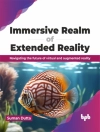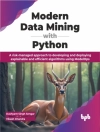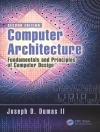This book provides in-depth explanations and discussions of the latest applications of Artificial Intelligence (AI), machine learning, and the Internet of Medicine, offering readers the cutting edge on this rapidly growing technology that has the potential to transform healthcare and improve patient outcomes.
Over the past five years, there have been significant advances in healthcare through the use of artificial intelligence (AI) and machine learning (ML) technologies. AI and machine learning in medical imaging has significantly improved the accuracy and speed of medical imaging analysis, accelerated the drug discovery process by identifying potential drug targets and predicting the efficacy and safety of new drugs, and enabled personalized medicine by analyzing large amounts of patient data to identify individualized treatment plans based on a patient’s genetic makeup and medical history. Internet of Medicine (Io M) refers to the integration of the Internet of Things (Io T) and connected medical devices with healthcare systems and processes to enable remote monitoring, diagnosis, and treatment of patients. Io M is a subset of the larger Internet of Things concept, which involves the connection of everyday devices and appliances to the internet for various purposes. Io M has the potential to revolutionize healthcare by improving patient outcomes, reducing costs, and increasing efficiency. Some of the specific applications of Io M include remote patient monitoring, real-time data analysis, predictive analytics, smart hospitals, and personalized medicine.
Tabela de Conteúdo
Preface xxiii
1 Omics Data Integration in AI System for Immediate and Carryover Effects of Neurodynamic Exercises on SLR Ranges Among Acute PIVD Patients 1
Durga Bahuguna, Vaibhav Agarwal and Manish Kumar Jha
1.1 Introduction 2
1.2 Literature Review 3
1.3 Methodology 7
1.4 Hypothesis 8
1.5 Procedure 12
1.6 Intervention 13
1.7 Data Analysis 14
1.8 Result 14
1.9 Discussion 17
1.10 Conclusion 19
References 19
2 Effectiveness of Graph-Based Methods for Biological Networks for Primal Reflex Release Techniques on Pain and Disability in Cervicogenic Headache Patient 23
Siddhartha Kuriyal, Manish Kumar Jha, Vaibhav Agarwal and Amit Sharma
2.1 Introduction 23
2.2 Literature Review 26
2.3 Methodology 30
2.4 Procedure 32
2.5 Conclusion 40
References 40
3 Application of AI in Determining Immediate and Carryover Effects of Primal Reflex Release Technique Neural Reboot on SI Joint Mobility 43
Rakesh Chaudhary, Vaibhav Agarwal and Aashish Negi
3.1 Introduction 44
3.2 Literature Review 45
3.3 Methodology 49
3.4 Results 52
3.5 Conclusion 60
References 60
4 Future Trends in Bioinformatics AI Integration for Analyzing Immediate Effect of Primal Reflex Release Technique in Neck Pain and Stiffness Patients 65
Aditya Sharma, Manish Kumar Jha, Vaibhav Agarwal and Amit Sharma
4.1 Introduction 66
4.2 Literature Review 70
4.3 Methodology 73
4.4 Conclusion 85
References 86
5 Evolutionary Computation in Bioinformatics Analyzing the Effects of Neurodynamic Exercises on Pain and Disability in Carpal Tunnel Syndrome Patients 89
Manish Pathak, Vaibhav Agarwal and Manish Kumar Jha
5.1 Introduction 90
5.2 Literature Review 93
5.3 Methodology 95
5.4 Result and Discussion 101
5.5 Conclusion 107
References 108
6 Imperative Role of Artificial Intelligence and Nanotechnology in Healthcare Sector for Sustainable Development 111
Sheela Bijlwan
6.1 Introduction 112
6.2 Literature Review 114
6.3 AI Applications in Healthcare Industries 115
6.4 Application of AI and Nanotechnology in Medicine 116
6.5 AI and Nanotechnology in Anti-Aging Medicines 117
6.6 Result 119
6.7 Discussion 119
6.8 Conclusion 122
References 122
7 Holistic Approaches for Sleep Pattern Enhancement Using AI and Yoga Therapy: A Comprehensive Scientific Approach 127
Somlata Jha and Siddhant Rajhans
7.1 Introduction 127
7.2 Understanding Sleep Patterns 128
7.3 The Importance of Quality Sleep 128
7.4 The Role of AI in Sleep Pattern Enhancement 128
7.5 How AI Works to Enhance Sleep 129
7.6 How Yoga Influences Sleep 129
7.7 Combining AI and Yoga for Better Sleep 130
7.8 The Synergy of AI and Yoga 130
7.9 Scientific Research on Sleep Improvement 131
7.10 The Mind–Body Connection 131
7.11 A Holistic Approach to Sleep 132
7.12 Practicing Yoga for Better Sleep 133
7.13 AI-Enabled Sleep Tracking Devices 134
7.14 Personalized Sleep Plans 135
7.15 Lifestyle Factors and Sleep 135
7.16 Conclusion 136
References 137
8 Ethical Consideration in Bioinformatics in AI for Analyzing the Effects of Using SHAT Device on Upper Extremity Functions in Stroke Patients 139
Kapil Lakhwara, Vaibhav Agarwal and Manish Kumar Jha
8.1 Introduction 140
8.2 SHAT Device (Synchronized Hand Arm Training Device) 141
8.3 How to Perform SHAT Exercises 141
8.4 Literature Review 143
8.5 Methodology 146
8.6 Protocol 147
8.7 Procedure 148
8.8 Results 149
8.9 Discussion 152
8.10 Conclusion 154
References 155
9 AI-Driven Drug Discovery and Repurposing for Analyzing Long-Term Effects of Nerve Sliders and Tensioners on Quality of Life in Cervicogenic Headache Patients 159
Shashwat Pandya, Manish Kumar Jha, Vaibhav Agarwal and Amit Sharma
9.1 Introduction 160
9.2 Literature Review 163
9.3 Methodology 166
9.4 Protocol 168
9.5 Procedure 168
9.6 Discussion 174
9.7 Conclusion 176
References 177
10 Using Artificial Intelligence (AI) Analyzing Recent Advancements in the Anti-Cancerous Properties of Edible Mushrooms and Their Association with the Mode of Action of Polysaccharides 181
Vishal Rajput, Manish Tenguria, Sanjay Gupta, Neha Sharma and Smriti Rai
10.1 Introduction 182
10.2 Polysaccharide Metabolism and Bioavailability 184
10.3 Conclusion 196
References 197
11 Impact of Artificial Intelligence (AI) in Bioremediation of Dairy Effluent by Microalgae and the Potential Application of the Produced Lipid Byproducts 201
Nisha Dhillon, Vivek Kumar, Geeta Bhandari and Sanjay Gupta
11.1 Introduction 202
11.2 Microalgae 204
11.3 Lipid-Producing Microalgal Strains 204
11.4 Biosynthesis of Lipid in Microalgae 208
11.5 Applications of Microalgal Lipids 211
11.6 Challenges in the Field of Microalgal Biomass Productivity 217
11.7 Conclusion 218
References 219
12 Smart Collision Recognition and Reporting System with GPS and GSM Integration 223
Gaurav Aggarwal, Pooja Joshi and Ashutosh Bhatt
12.1 Introduction 224
12.2 Literature Review 225
12.3 Block Diagram 226
12.4 Methodology 226
12.5 Conclusion 233
References 234
13 Evolution and Impact of Wearable Devices in Healthcare: Anatomy of Wearable Technology and its Influence on Medical Sciences 237
M. P. Ambali and V. C. Patil
13.1 Introduction 238
13.2 Historical Development of Wearable Technology 242
13.3 Anatomy of Wearable Technology 244
13.4 Types of Wearable Devices in Healthcare 248
13.5 Applications of Wearable Technology in Medical Sciences 251
13.6 Impact of Wearable Technology on Healthcare 254
13.7 Future Trends and Innovations in Wearable Technology 258
13.8 Conclusion 259
References 260
14 Current State of Wearable Healthcare Technology: Physiology and Biochemistry of Wearable Sensors and Devices 263
Jyotsna A. Patil and Shrirang N. Patil
14.1 Introduction 264
14.2 Physiological Monitoring 266
14.3 Biochemical Monitoring 269
14.4 Integration of Sensors and Devices 271
14.5 Applications in Healthcare 275
14.6 Advances in Data Analytics and Artificial Intelligence 277
14.7 Challenges and Future Directions 279
14.8 Conclusion 284
References 285
15 Real-Time Data Acquisition and Analysis Techniques: Microbiological and Immunological Aspects of Real-Time Health Data Collection 287
Satish R. Patil and Supriya S. Patil
15.1 Introduction 288
15.2 Real-Time Microbiological Data Collection 292
15.3 Real-Time Immunological Data Collection 297
15.4 Technology and Tools for Real-Time Data Collection 302
15.5 Data Analysis Techniques 305
15.6 Case Studies and Applications 308
15.7 Future Directions and Challenges 311
15.8 Conclusion 313
References 314
16 Applications of Real-Time Data in Healthcare Interventions: Pharmacological Interventions Based on Real-Time Data Analytics 317
V. M. Thorat and Satish V. Kakade
16.1 Introduction 318
16.2 Personalized Medicine 323
16.3 Treatment Efficacy 327
16.4 Proactive Interventions 332
16.5 Clinical Trials 334
16.6 Challenges and Future Directions 339
16.7 Conclusion 343
References 343
17 Strategies for Integrating Wearable Technology with Healthcare Systems: Pathological Considerations in Wearable Device Integration 347
Sujata Raghunath Kanetkar and Vaishali V. Raje
17.1 Introduction 348
17.2 Pathological Considerations in Wearable Device Integration 352
17.3 Strategies for Effective Integration 357
17.4 Case Studies and Examples 362
17.5 Future Directions and Emerging Trends 366
17.6 Conclusion 370
References 371
18 Challenges and Solutions in Healthcare System Integration: Histological Perspectives on Wearable Device Integration Challenges 373
Yugantara R. Kadam and Sujata Raghunath Kanetkar
18.1 Introduction 374
18.2 Challenges in Integrating Wearable Devices 377
18.3 Interoperability Challenges 381
18.4 Security and Privacy Concerns 383
18.5 Accuracy and Reliability of Data 387
18.6 Scalability and Sustainability 390
18.7 Solutions to Integration Challenges 395
18.8 Case Studies and Best Practices 398
18.9 Future Trends and Outlook 400
18.10 Conclusion 402
References 402
19 Role of Wearable Technology in Mental Health Monitoring and Management: Psychiatric Insights into Wearable Technology Adoption 405
Sharad V. Kshirsagar and V. C. Patil
19.1 Introduction 406
19.2 Adoption of Wearable Technology in Mental Healthcare 410
19.3 Data Privacy and Security in Mental Healthcare 414
19.4 Potential Impact of Wearable Technology in Mental Healthcare 418
19.5 Case Studies and Examples 421
19.6 Future Directions and Challenges 424
19.7 Conclusion 425
References 426
20 Ethical Considerations in Mental Health Data Collection and Analysis: Ethical and Legal Aspects of Mental Health Data in Wearable Technology 429
V. M. Thorat and M. P. Ambali
20.1 Introduction 430
20.2 Ethical Principles in Mental Health Data Collection and Analysis 433
20.3 Legal Frameworks for Mental Health Data in Wearable Technology 435
20.4 Informed Consent in Wearable Technology 436
20.5 Data Security and Privacy in Mental Health Wearables 438
20.6 Potential Misuse of Mental Health Data 441
20.7 Ensuring Equity in Access to Mental Health Wearables 442
20.8 Ethical Guidelines for Researchers and Practitioners 444
20.9 Conclusion 446
References 446
21 Ethical Challenges and Guidelines for AI Deployment in Healthcare: Urological and Gastroenterological Perspectives on Ethical AI Deployment 449
Sujata Raghunath Kanetkar and V. M. Thorat
21.1 Introduction 450
21.2 Ethical Principles in AI Deployment 453
21.3 Challenges in AI Deployment in Urology and Gastroenterology 456
21.4 Guidelines for Ethical AI Deployment in Urology and Gastroenterology 458
21.5 Case Studies 463
21.6 Future Directions and Recommendations 465
21.7 Conclusion 466
References 467
22 Future Directions and Opportunities in AI-Driven Healthcare: Family Medicine and Anesthesiological Future Directions in AI-Driven Healthcare 469
Vithal K. Dhulkhed and Shekhar M. Kumbhar
22.1 Introduction 470
22.2 AI Applications in Family Medicine 472
22.3 AI Applications in Anesthesiology 475
22.4 Current Challenges and Limitations 478
22.5 Future Directions and Opportunities 480
22.6 Case Studies and Examples 482
22.7 Conclusion 484
References 485
About the Editors 489
Index 493
Sobre o autor
Abhishek Kumar, Ph D, is an assistant director and associate professor in the Computer Science and Engineering Department in Chandigarh University, Punjab, India. He has over 13 years of academic experience with more than 100 publications in reputed, peer-reviewed national and international journals, books, and conferences. Additionally, he has also authored six books and edited 25 books that have been internationally published. He is also a member of various national and international professional societies in the field of engineering and research, including the Institute of Electrical and Electronics Engineers, International Association of Engineers, and Institute of Research Engineers and Doctors.
Narayan Vyas is a principal research consultant at AVN Innovations, where he is actively involved in research and development in computer science and engineering. He qualified for the National Testing Agency’s University Grants Commission National Eligibility Test and Junior Research Fellowship on his first attempt, showcasing his academic excellence. He has published many articles in reputed, peer-reviewed national and international Scopus journals and conferences. Additionally, he has served as a keynote speaker and resource person for several workshops and webinars conducted in India.
Pramod Singh Rathore is an assistant professor in the Department of Computer and Communication Engineering, Manipal University, Jaipur. With over 11 years of academic teaching experience, he has published more than 55 papers in reputable, peer-reviewed national and international journals, books, and conferences and co-authored and edited numerous books with well-known publishers. He serves on the editorial and advisory committees of the Global Journal Group and is a member of various national and international professional societies in the field of engineering and research, including the International Association of Engineers.
Abhineet Anand, Ph D, is the Director in the department of Advanced Information Technology-Computer Science and Engineering, Chandigarh University with over 22 years of experience. He has published more than 40 Scopus-indexed papers, 25 papers in international conferences, eight international journals, three national journals, and three national conferences. He has been part of 20 special sessions at various international conferences as a session chair/co-chair and contributed at 20 different conferences as a Technical Program Committee member.
Pooja Dixit is visiting faculty in the Department of Computer Science and Engineering, Maharshi Dayanand Saraswati University, Ajmer, India with over eight years of experience. She has published many papers in reputable, peer-reviewed national and international journals, books, and conferences. Her research includes Artificial intelligence, Data Mining, Machine Learning, and Internet of Things.












